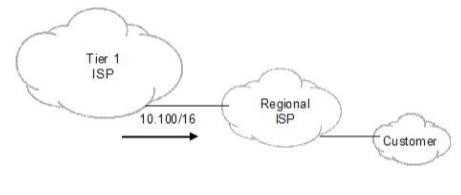You work for the regional Internet service provider shown in the exhibit You have a partial BGP table and are receiving a 10 100/16 route from your upstream ISP You have been asked to configure a default route that can be sent to your downstream customer This route should forward customer traffic toward your upstream Tier 11SP as long as the 10.100/16 route is present.
What would accomplish this goal?

A.
Create and announce an aggregate default route
B.
Create and announce a static default route with a next-hop of discard
C.
Create and announce a static default route with a next-hop of reject
D.
Create and announce a generated default route
E.
Create an advertise-map with exist-map
Explanation:
Reference:http://www.juniper.fr/techpubs/en_US/junose10.0/information-products/topic-collections/swconfig- bgp-mpls/advertising-a-default-route-only-when-another-route-is-present.html



I just passed the exam and there is no command advertise-map or exist-map in Juniper and in also this choice not exist in the exam
the correct answer D
0
0
thanks for your info
0
0
Hi Badawy,
Would you please explain why ans A is not correct?? Additionally, the task was to do advertise the route along with aggregation based on certain condition (existance of the BGP route in this case) , which makes me think toward aggregate route instead of generated routes.
0
0
Aggregate routes are quite like generate routes in that they become active when a contributing route is present from a peer or neighbour. What’s different is that the aggregate route always has a discard or reject, so isn’t used to forward traffic. A generate route has a preferred contributing route, and this is used to forward the traffic even in the event that there isn’t a contributing route matching the packet’s destination.
In real-world usage, aggregates are used by people to summarise their address space into a single block to keep the Internet routing table smaller.
Generate routes are usually used at the edge of a network to generate a conditional default route into the IGP if there are any routes received from the upstream ISP.
so if E is not there then D is preferred answer
0
0
look, answer E and the explanation are 100% correct, but for the E-Series. This track deals with M/MX/T, so the D is correct
0
0